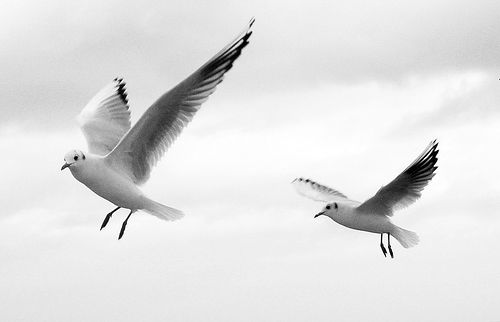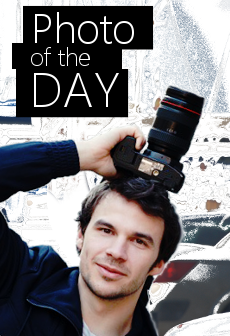Carol Berg

Photo: lenny_montana
Tomas Transtromer writes in the opening poem “Prelude” of his Selected Poems, “consciousness can own the world” and this philosophy informs much of his poetry. Transtromer’s own consciousness deeply engages his world, sometimes with dread as his consciousness reflects Nature’s cold aloofness, as in his poem “Face to Face,” and sometime with such intensity, as in the poem “A Part of the Forest,” that it is difficult to separate where a metaphoric journey into Nature begins and where the speaker’s consciousness ends.
In many of Transtromer’s poems, time slows down to show the speaker’s mind as it absorbs its surrounding. Often a dream-like consciousness interrupts the speaker’s life to split it open for close examination. In many of his poems how the speaker encounters Nature directly influences how the speaker encounters himself.
And in two of Transtromer’s poems his use of form mirrors his engagement with Nature. In the poem “A Part of the Forest” Transtromer uses the prose poem to show deep commitment and unification with Nature, while in “Face to Face” he splits the poem into stanzas to reflect a split between the speaker and his environment.
Paul Fussell states that “the white space between stanzas mean something” (155) and in the poem “Face to Face” Transtromer uses stanzas to show separation from Nature as well as stasis of Nature and speaker. Transtromer uses almost all end-stopped lines to create a full block between Nature and man. The first stanza reads
In February living stood still.
The birds flew unwillingly and the soul
chafed against the landscape as a boat
chafes against the pier it lies moored to. (lines 1-4)
The speaker is not in the first stanza, only an unidentified soul. Transtromer does not write, for example, “my” soul. Transtromer is detailing a cold Nature. It is February and everything is stopped. This coldness and “unwilling” landscape deeply effects the soul which feels “chafed.” The word chafed means “1. to feel irritation or discontent 2. to rub and thereby cause wear or irritation” (“Chafe”).
It is significant that the soul is rubbing against nature, and nature, stilled, can only cause irritation to the soul. The soul is compared to a boat here and these two lines are the only enjambed lines of the poem, creating a connection between soul and boat. This comparison of the soul with a boat is significant in that the boat becomes anthropomorphized and wants movement. Instead it is tied to the pier.
This anthropomorphizing continues into stanza two with the trees as they “stood with their backs turned toward me” (line 5). Stasis in Nature effects the speaker. The speaker feels that the trees have purposefully turned away, creating a separation. Transtromer continues to pile on the images in this stanza which creates weight and dread. These images are “deep snow…measured with dead straw” and “footprints” that “grew old out on the crust” (lines 6, 7).
The sentence structure of lines 5 through 7 are similar, beginning with the word “The” and continuing with the subject, verb, and object format. This sameness to the language adds a heaviness to the lines as does their long length and the fact that they are end-stopped. This heaviness seizes even language: “Under a tarpaulin language pined” (line 8). The weight deepens the stasis created in the lines above, too, as all of language, which includes the language of Nature and speaker, is trapped under this manmade material.
In the third and final stanza, this stasis ends as “something comes to the window” (line 9). Here we have movement. Even more important, this something is seeking the speaker out. And here, both Nature and the speaker in action. This signifies a change. Movement continues throughout the stanza as “Work was dropped, I looked up” (line 10) and it is key that the speaker had his head down with work, signifying dread, but now is able to look up again.
The intensity of movement increases as “colors flared. Everything turned round” (line 11) with the word “round” such a wonderful choice of verb here. Not only does it suggest energy, but also the idea of the smoothness, like a round stone (another of Transtromer’s favorite images) juxtaposed with the “chafing” in the first stanza. This movement culminates in the last line: “The earth and I sprang towards each other” (line 12), creating a sense of delight, and, perhaps most importantly, creating an equal encounter of Nature with speaker where there had been separation.
In Transtromer’s later poem “A Part of the Forest” the encounter between Nature and speaker is such that it is difficult to tell where Nature ends and the speaker’s consciousness begins. This poem is a prose poem, therefore there is no white space to signify separation. The New Princeton Encyclopedia of Poetry and Poetics states that one of the characteristics of prose poems is “sustained intensity and compactness,” (Caws “Prose Poem”) strong characteristics of this poem.
The definition in the Encyclopedia continues, “the prose poem aims at knowing or finding out something not accessible under the more restrictive conventions of verse” (ibid). This “finding out” is the subject of Transtromer’s poem and he reveals it in stages by placing the reader deeper into a safe and natural environment that he creates in this prose poem.
The poem begins, “On the way there” and immediately the reader is participating in a journey but rather blindly. Transtromer creates a sense of mood with the only sound as “a pair of frightened wings” which “clattered up” (line 1). It is remarkable that these wings are unidentified. It is as if Transtromer were chasing away all fear.
Significantly “you walk alone” and so this is a journey of the reader, written in second-person pronoun. The journey moves into “a high building” which could be perilous as it is made of “narrow/cracks” (2, 3), but even though this building is “always swaying”(3) Transtromer stresses that it “never falls” (3). This is necessary motion, unlike the stasis in Nature in “Face to Face.”
Nature surrounds and envelops the “you” in the form of the “thousandfold/sun” and the intensity of the light is such that not only is it “thousandfold” but can actually change the law of gravity: “In the play of light an inverted law of/gravity prevails” (lines 4,5). Here Transtromer transforms our world with the use of scientific language: “law of\gravity.”
The reader and “you” of the poem are forced to participate in this shift of perception. And suddenly, the building is changed again into a “house” that is “anchored in the sky” (line 5). The journey moves more and more into the personal, from a building into a house. And the structure of the house now becomes sturdier as it is “anchored” significantly, with Nature.
Transtromer continues to secure our world by stating that “and everything that falls/falls up” which creates a lightness, a kind of safety net hung above, rather than below. Transtromer is positioning a new world for us in an effort to shake out of us our past obsessions.
Not only is the building changing, but the “you” of the poem now has the ability to change too: “You can turn around there. You can mourn there” (line 6). Here there is space to move and space to mourn. Transtromer suggests to the “you” of the poem to turn around and face yourself and that this self will probably need to mourn. But this directive is made with the words “can” repeated twice. Nothing is being forced here and there is a gentleness of tone.
The speaker repeats the word “there” three times in line 6 to deepen the reality of this positioning. He begins line 7 with the word “dare” which rhymes with “there” and gives the “you” courage and permission to “look at certain old truths that otherwise are always packed away” (line 7). The journey has become intensely personal and interior.
In line 8, the speaker joins the “you” of the poem by showing what truths he is facing. But the speaker is also careful to continue building a place in Nature of safety and familial support as he “unpacks” what he has hidden. These things he is unpacking, though they hang “like dried skulls,” (line are hanging “in the/ancestors’ hut” with an “atmosphere of childhood/around the spooky trophies” (9, 10).
By unpacking his “old truths” we are encouraged to unpack ours, and see them with a new eye. He continues arranging our space so that we are provided a sense of acceptance within the love of family and the security of childhood.
This journey has taken us long distances physically and mentally, simultaneously taking us farther out of the walls we normally build into our deeper selves by creating a building that may be cracking but is ultimately safer than our constructed buildings where we hide our truths. This is a place in Nature where our ancestors have journeyed as well.
Transtromer ends the poem with the sentence, “It’s so mild in the forest” (line 10) and our journey is completed as the true nature of ourselves is revealed. We are all part of the forest and, when we face our true selves, become mild—instead of being agitated with the business of building bricks as high as we can to hide ourselves in.
In these two poems, Transtromer shows different levels of his engagement with Nature. In his earlier poem, “Face to Face” when the speaker of the poem is separated from Nature his soul is stopped and his language muted, heavy and trapped. Transtromer shows the reader that motion is necessary for life. In his later poem “A Part of Nature” Transtromer creates a metaphoric place in Nature, where our deep consciousness connects us to ourselves. This, in turn, connects us more constructively with our ancestral earth.
Works Cited
Caws, Mary Ann. “Prose Poem.” The New Princeton Encyclopedia of Poetry and Poetics. 1993.
“Chafe.” Webster’s Ninth New Collegiate Dictionary. 1991.
Fussell, Paul. Poetic Meter and Poetic Form. Revised ed. New York: McGraw-Hill, Inc., 1979.
Transtromer, Tomas. Selected Poems 1954-1986. Ed. Robert Hass. New York: The Ecco Press, 1987.











No comments so far ↓
Nobody has commented yet. Be the first!
Comment